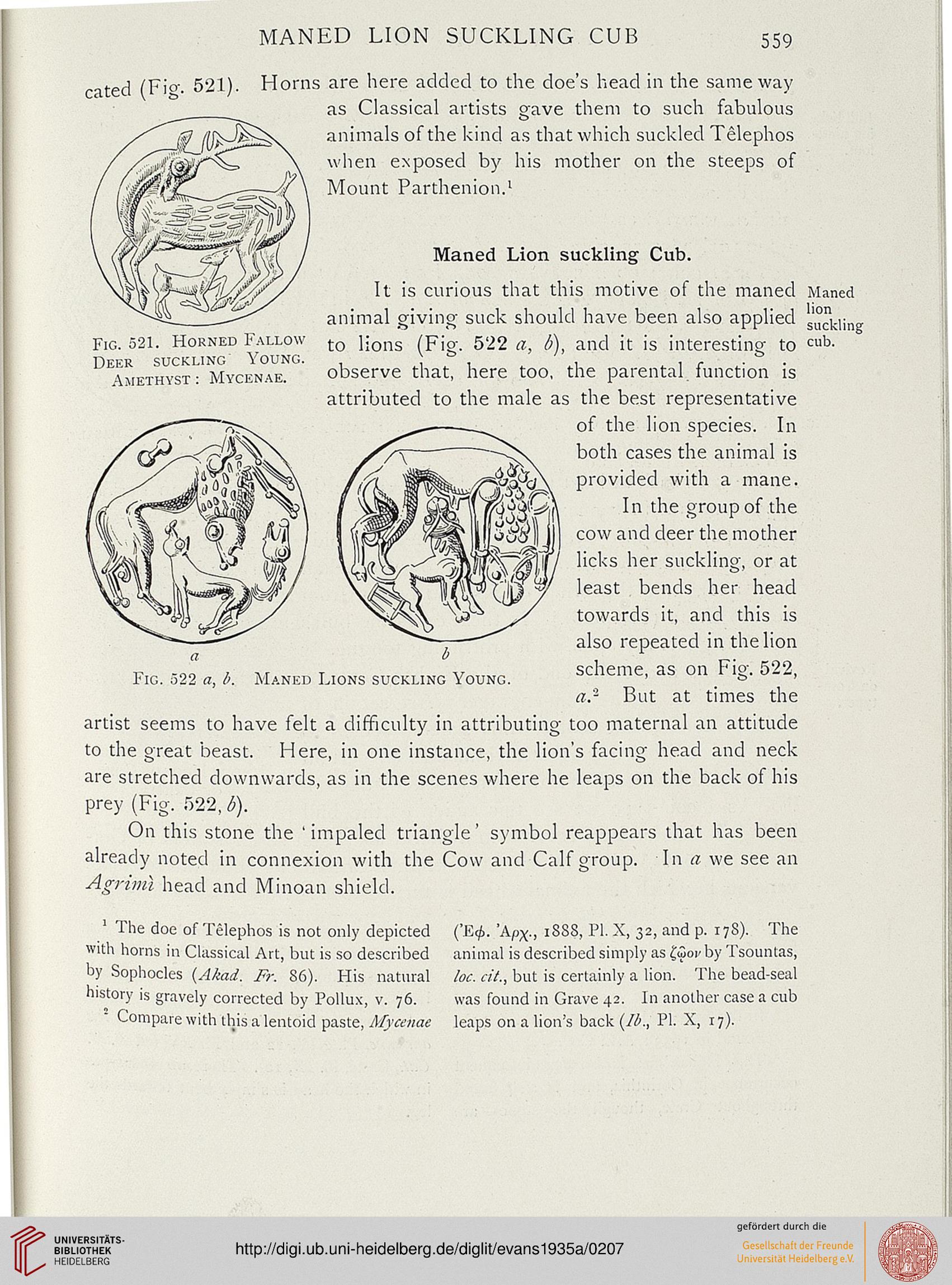MANED LION SUCKLING CUB
559
ited (Fig. 521). Horns are here added to the doe's head in the same way
as Classical artists gave them to such fabulous
animals of the kind as that which suckled Telephos
when exposed by his mother on the steeps of
Mount Parthenion.1
Maned Lion suckling Cub.
It is curious that this motive of the maned Maned
animal giving suck should have been also applied s'™h;„„
to lions (Fig. 522 a, b\ and it is interesting to cl,b-
observe that, here too, the parental function is
attributed to the male as the best representative
of the lion species. In
both cases the animal is
provided with a mane.
In the group of die
cow and deer the mother
licks her suckling, or at
least bends her head
towards it, and this is
also repeated in the lion
scheme, as on Fig. 522,
a.2 But at times the
Fig. 521. Horned Fallow
Deer suckling Young.
Amethyst : Mycenae.
Fig. 522 a, b. Maned Lions suckling Young
artist seems to have felt a difficulty in attributing too maternal an attitude
to the great beast. Here, in one instance, the lion's facing head and neck
are stretched downwards, as in the scenes where he leaps on the back of his
prey (Fig. 522, b).
On this stone the 'impaled triangle' symbol reappears that has been
already noted in connexion with the Cow and Calf group. In a we see an
Agrimi head and Minoan shield.
The doe of Telephos is not only depicted
with horns in Classical Art, but is so described
by Sophocles (A/tad. Ft: 86). His natural
history is gravely corrected by Pollux, v. 76.
- Compare with this a lentoid paste, Mycenae
(E<j>. 'Apx-, iSSS, PL X, 32, and p. 17S). The
animal is described simply as fSov by Tsountas,
he. cit., but is certainly a lion. The bead-seal
was found in Grave 42. In another case a cub
leaps on a lion's back (lb., PL X, 17).
559
ited (Fig. 521). Horns are here added to the doe's head in the same way
as Classical artists gave them to such fabulous
animals of the kind as that which suckled Telephos
when exposed by his mother on the steeps of
Mount Parthenion.1
Maned Lion suckling Cub.
It is curious that this motive of the maned Maned
animal giving suck should have been also applied s'™h;„„
to lions (Fig. 522 a, b\ and it is interesting to cl,b-
observe that, here too, the parental function is
attributed to the male as the best representative
of the lion species. In
both cases the animal is
provided with a mane.
In the group of die
cow and deer the mother
licks her suckling, or at
least bends her head
towards it, and this is
also repeated in the lion
scheme, as on Fig. 522,
a.2 But at times the
Fig. 521. Horned Fallow
Deer suckling Young.
Amethyst : Mycenae.
Fig. 522 a, b. Maned Lions suckling Young
artist seems to have felt a difficulty in attributing too maternal an attitude
to the great beast. Here, in one instance, the lion's facing head and neck
are stretched downwards, as in the scenes where he leaps on the back of his
prey (Fig. 522, b).
On this stone the 'impaled triangle' symbol reappears that has been
already noted in connexion with the Cow and Calf group. In a we see an
Agrimi head and Minoan shield.
The doe of Telephos is not only depicted
with horns in Classical Art, but is so described
by Sophocles (A/tad. Ft: 86). His natural
history is gravely corrected by Pollux, v. 76.
- Compare with this a lentoid paste, Mycenae
(E<j>. 'Apx-, iSSS, PL X, 32, and p. 17S). The
animal is described simply as fSov by Tsountas,
he. cit., but is certainly a lion. The bead-seal
was found in Grave 42. In another case a cub
leaps on a lion's back (lb., PL X, 17).





